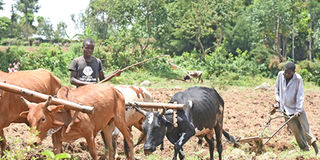Agronomist notebook: Locusts or no locusts, please ready your farm

Farmers plough land in preparation for planting in Vihiga County. Normally, ploughing helps expose pests and diseases that are in the soil to harsh environmental conditions such as the hot sun. PHOTO | ISAAC WALE | NATION MEDIA GROUP
What you need to know:
- Normally, the ploughing helps expose pests and diseases that are in the soil to harsh environmental conditions such as the hot sun.
- Most farmers, thus, are waiting for the rains to start proper so that they can plough, apply manure and plant. This should not be the case.
- Inorganic fertiliser should be applied during planting. Buy farm inputs from reputable companies. Genuine fertiliser applied at the right time of the crop growth leads to improvement of the soil health and the growth of the crops resulting in high yields.
- NPK stands for nitrogen, phosphorous and potassium while the figures indicate the availability of the nutrients in percentages.
Locust invasion and erratic rains have left farmers confused about the best time to commence planting this season.
March is usually the time to start planting for many farmers across the country in sync with the long rains season, which normally starts from this month to May.
Locust infestation in some counties is also coming in the way of farmers making plans to plant. This is a major setback since it is at this time that land clearing should have been carried out and the land ploughed to give weeds ample time to dry.
Normally, the ploughing helps expose pests and diseases that are in the soil to harsh environmental conditions such as the hot sun.
In many cases, however, ploughing the land and waiting for the rains often results to formation of hardpans in the soil.
Farmers, therefore, are forced to incur extra cost of harrowing the land to a fine tilth, depending on the kind of crop to be planted.
Most farmers, thus, are waiting for the rains to start proper so that they can plough, apply manure and plant. This should not be the case.
You should prepare the land for planting since waiting for the rains would result in delayed land preparation.
You see, it’s easy to transport and spread dry well-rotten manure during the dry season than waiting for it to be rained on. When it is rained on, especially in an open area, the leaching of nutrients takes place, making it loose them.
Manure needs to be incorporated into the soil. Therefore, one can opt to first spread the manure then plough the land if no harrowing will be done or plough the land, spread the manure and then harrow.
REQUIRED BY THE PLANT
After preparing the land, have the soil tested as this will guide you on the kind of crops to be planted and the right fertiliser to purchase and apply at a particular time depending on the crop nutritional requirements. Purchase fertilisers early enough to avoid last-minute rush that results in high prices or stock outs.
Inorganic fertiliser should be applied during planting. Buy farm inputs from reputable companies. Genuine fertiliser applied at the right time of the crop growth leads to improvement of the soil health and the growth of the crops resulting in high yields.
While purchasing the fertilisers, check on the contents listed on the bags, for instance, N:P:K 17:17:17. Check the batch number and the purity of the fertiliser.
NPK stands for nitrogen, phosphorous and potassium while the figures indicate the availability of the nutrients in percentages.
This is the primary level of macronutrients required by the plant for growth where nitrogen helps in vegetative growth, phosphorous for root development and potassium for fruit formation and the overall functioning of the plant.
As for seeds, buy certified ones from reputable companies as this is the first step towards achieving a bumper harvest.
Ensure you maintain all the records, for instance, the cost incurred, the germination percentage and all the scouting details since this would be essential in the next production and help you determine if you made a profit or not.
For vegetative propagation materials, ensure they are free of pests and diseases.
Purchase adequate seedlings that will give quality results since there may be no extra cost of treating in case of disease infestation.
Learn from the mistakes that you made in the previous year. Check on your spacing to maximise production per unit area.





